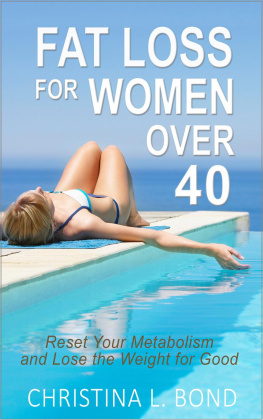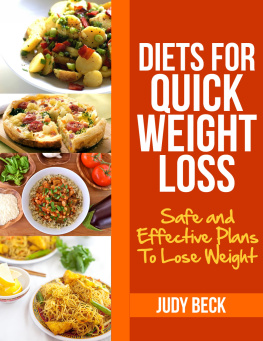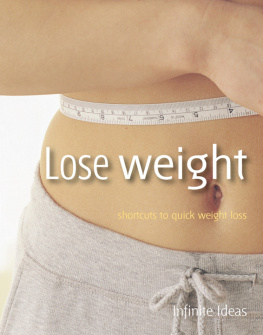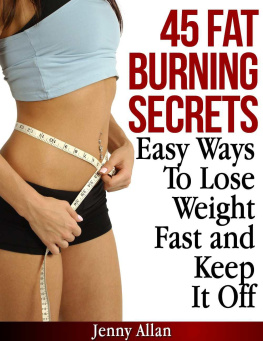Fat Loss for Women Over 40: How to Reset Your Metabolism and Lose the Weight for Good
By
Christina L. Bond
Christina L. Bond 2015. All Rights Reserved.
No part of this publication may be reproduced in any form or by any means, including scanning, photocopying, or otherwise without prior written permission of the publisher or copyright owner.
This book is a general educational health-related information product. As an express condition to reading this book, you understand and agree to following terms. The information and advice contained in this book are not intended as a substitute for consulting with a healthcare professional. The author and publisher are not responsible for any adverse effects or consequences resulting from the use of any of the suggestions, plans, or procedures discussed in this book. While all attempts have been made to verify information provided in this book, the author and publisher assume no responsibility for errors, omissions, or contrary interpretation of the subject matter herein. All matters pertaining to your physical health should be supervised by a health care professional.
Introduction
M any women, once they reach and pass the age of 40, notice that it suddenly becomes easier to gain a few pounds here and there than to lose those pounds. The foods you enjoyed with abandon in your 20s and 30s now seem to have turned on you, sticking to your body stubbornly and unflatteringly. You may grow frustrated, and believe that your only choice is to resign yourself to this new, unfamiliar shape. You may assume that weight gain is an inevitable part of aging.
But you dont have to, and it isnt. Those jeans that have suddenly become too tight, the puffy mid-section, and the increased risk of diabetes dont have to be part of your future. Weight loss and healthy living in your 40s and beyond is different than weight loss in your 20s and 30s. Not harder, but different. You have to change your strategy. Those tricks that worked for you previously will no longer work, but other methods will. I promise. Its possible and doable and, thankfully, far easier than you thought.
The secret to weight loss (and, more specifically, fat loss) after the age of 40 is not the number of minutes spent on the elliptical or the latest juice fast. Instead, the key to a slim, toned, sexy body in your 40s and beyond lies just as far as your refrigerator (and a pair of light dumbbells). Research has very clearly shown that a certain way of eating, combined with a certain type of regular (but not excessive) exercise will give you your very own metabolic secret weapon for sculpting the body you want.
Why Do We Gain Weight As We Get Older?
E very new stage of life brings with it its own set of challenges. One issue we all deal with as we reach and pass our 40s is undesired weight gain. According to the National Health and Nutrition Examination Survey, the most significant leap in the percentage of women who become overweight or obese happens between the ages of 40 and 59. The main culprit behind this jump? Hormones.
As we get older, the balance of our hormones shifts in a way that encourages weight gain. Estrogen levels begin to decline, which means that fat is metabolized differently (as subcutaneous fat). Our insulin-regulating hormones becomes less effective, which slows down our metabolism and decreases our muscle mass, while at the same time draining our energy and increasing belly fat.
And shrinking muscle mass is no joke. It is the main culprit behind the slower metabolism that often causes women to engage in the dreaded (and dangerous) yo-yo dieting. Beginning around the age of 30, most people begin to lose about half a pound of muscle tissuethe very tissue responsible for keeping our metabolism revved upevery year. At the age of 50, that rate doubles. Thus, the average sedentary woman may lose almost fifteen pounds of muscle by the time she nears sixty. This change will cause that woman to gain nearly the same amount in body fat.
The changes associated with reaching midlife are not to be feared. They are a normal part of aging, and we all experience them. The key, then, is not to agonize over the changes in your body, but to learn how to work with them and to arm yourself with the right strategies to lose your particular brand of unwanted body fat.
Say Good-Bye to Dieting
I f, like many women over forty, youve been putting on some extra pounds, youve probably gone on a diet (or planned to go on a diet) at some point. However, youve probably also learned by this point in your life that diets dont work, at least not in the long run. Nor do sudden, extreme exercise regimens. Theres a reason for this. Our weight stays pretty constant from week to week, even if one day we enjoy a junk food binge and the next day we return to a fairly healthy diet. Our bodies are designed to maintain a steady metabolic rate, which, evolutionarily, helps us to get through food shortages and sudden demands for spikes of activity.
The bad news, of course, is that as youve gradually added on pounds, your body has adapted to the extra weight and now wants to hang on to it. Thats why dieting wont help. Instead, you have to make slow, gradual adjustments to your eating (and exercise) habits, ones that you can incorporate into your routine every day and stick with long term. The last thing you want to do is to be overwhelmed or get in over your head. In fact, studies indicate that those of us who take the slow-but-steady approach to weight loss are far more like to keep the weight off permanently.
When You Eat Matters
W hen you reach your forties, the main objective with respect to your eating is to keep yourself feeling satisfied without giving in to eating like you did when you were 20. How to do so? The trick is to eat small meals, frequently. Youve probably heard this advice many times before and theres a reason for thatits good, effective advice. Despite what many fasting enthusiasts say, light, frequent meals keep metabolic levels high and, as an added benefit, keep your blood sugar steady so that you wont feel exhausted or tempted to binge.
Your objective with this type of eating schedule is the opposite of the fasting/starvation approach. You want your body to feel well-fed at pretty much all times, even though youre actually not eating all that much. You do this by eating five or six small meals every day, with no more than three or four hours between each meal. An example of a small meal might be a piece of whole wheat toast and a cup of yogurt, a turkey and lettuce wrap, a healthy salad with a low-fat dressing, a piece of lean meat with steamed vegetables, a bowl of soup, etc. If you know that your next meal is only a few short hours away, its easier to eat less at each meal and easier to say no to that sweet treat parading in front of your face at 2 in the afternoon.
Spacing of meals matters, and, whats more, so does timing. Most experts agree that you should avoid eating any snacks (and certainly dinner) after about 8 p.m. Food consumed after that time is more likely to end up on your stomach and hips. On the other hand, its vitally important that you eat breakfast. The food you eat in the morning (which is the time when your metabolism is really revved up) is much more likely to be used efficiently by the body.
Eating breakfast is one of those habits that really differentiates thin people from overweight people. A survey of members of the National Weight Control Registry found that, of members who have maintained a weight loss of at least 30 pounds for at least one year, 78 percent reported that they eat breakfast every day and a whopping 90 percent reported that they eat breakfast at least five days per week. The habit of eating breakfast was one of the only factors held in common by those who successfully kept off the weight.
Next page





